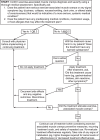An Evidence-Based Review of the Pathophysiology, Treatment, and Prevention of Exercise-Associated Muscle Cramps
- PMID: 34185846
- PMCID: PMC8775277
- DOI: 10.4085/1062-6050-0696.20
An Evidence-Based Review of the Pathophysiology, Treatment, and Prevention of Exercise-Associated Muscle Cramps
Abstract
Exercise-associated muscle cramps (EAMCs) are common and frustrating for athletes and the physically active. We critically appraised the EAMC literature to provide evidence-based treatment and prevention recommendations. Although the pathophysiology of EAMCs appears controversial, recent evidence suggests that EAMCs are due to a confluence of unique intrinsic and extrinsic factors rather than a singular cause. The treatment of acute EAMCs continues to include self-applied or clinician-guided gentle static stretching until symptoms abate. Once the painful EAMCs are alleviated, the clinician can continue treatment on the sidelines by focusing on patient-specific risk factors that may have contributed to the onset of EAMCs. For EAMC prevention, clinicians should obtain a thorough medical history and then identify any unique risk factors. Individualizing EAMC prevention strategies will likely be more effective than generalized advice (eg, drink more fluids).
Keywords: best practice; dehydration; electrolytes; fatigue; risk factors.
© by the National Athletic Trainers' Association, Inc.
Figures


Similar articles
-
Does Prophylactic Stretching Reduce the Occurrence of Exercise-Associated Muscle Cramping? A Critically Appraised Topic.J Sport Rehabil. 2023 Sep 27;33(1):49-52. doi: 10.1123/jsr.2022-0374. Print 2024 Jan 1. J Sport Rehabil. 2023. PMID: 37758261
-
Factors associated with a self-reported history of exercise-associated muscle cramps in Ironman triathletes: a case-control study.Clin J Sport Med. 2011 May;21(3):204-10. doi: 10.1097/JSM.0b013e31820bcbfd. Clin J Sport Med. 2011. PMID: 21430526
-
Increased running speed and previous cramps rather than dehydration or serum sodium changes predict exercise-associated muscle cramping: a prospective cohort study in 210 Ironman triathletes.Br J Sports Med. 2011 Jun;45(8):650-6. doi: 10.1136/bjsm.2010.078535. Epub 2010 Dec 9. Br J Sports Med. 2011. PMID: 21148567
-
Muscle cramping in athletes--risk factors, clinical assessment, and management.Clin Sports Med. 2008 Jan;27(1):183-94, ix-x. doi: 10.1016/j.csm.2007.09.006. Clin Sports Med. 2008. PMID: 18206574 Review.
-
Aetiology of skeletal muscle 'cramps' during exercise: a novel hypothesis.J Sports Sci. 1997 Jun;15(3):277-85. doi: 10.1080/026404197367281. J Sports Sci. 1997. PMID: 9232553 Review.
Cited by
-
Effect of forearm compression sleeve on muscle fatigue during robotic surgery: a randomized controlled study.J Minim Invasive Surg. 2025 Mar 15;28(1):11-18. doi: 10.7602/jmis.2025.28.1.11. J Minim Invasive Surg. 2025. PMID: 40090372 Free PMC article.
-
A scoping review on muscle cramps and spasms in upper motor neuron disorder-two sides of the same coin?Front Neurol. 2024 Mar 1;15:1360521. doi: 10.3389/fneur.2024.1360521. eCollection 2024. Front Neurol. 2024. PMID: 38497037 Free PMC article.
-
Muscle Cramps in Outpatients with Liver Diseases in Tokyo, Japan.Medicina (Kaunas). 2023 Aug 22;59(9):1506. doi: 10.3390/medicina59091506. Medicina (Kaunas). 2023. PMID: 37763625 Free PMC article.
-
A pharmacovigilance study of the association between linaclotide/plecanatide and muscle spasms based on food and drug administration adverse event reporting system.Front Pharmacol. 2025 Aug 6;16:1635792. doi: 10.3389/fphar.2025.1635792. eCollection 2025. Front Pharmacol. 2025. PMID: 40843382 Free PMC article.
-
IOC consensus statement on recommendations and regulations for sport events in the heat.Br J Sports Med. 2023 Jan;57(1):8-25. doi: 10.1136/bjsports-2022-105942. Epub 2022 Sep 23. Br J Sports Med. 2023. PMID: 36150754 Free PMC article.
References
-
- Schwabe K, Schwellnus MP, Derman W, Swanevelder S, Jordaan E. Less experience and running pace are potential risk factors for medical complications during a 56 km road running race: a prospective study in 26 354 race starters—SAFER study II. Br J Sports Med . 2014;48(11):905–911. doi: 10.1136/bjsports-2014-093471. - DOI - PubMed
-
- Miller KC. WM Adams, Jardine JF., editors. Exercise-associated muscle cramps. Exertional Heat Illness A Clinical and EvidenceBased Guide . 2020. Springer; 117–136.
Publication types
MeSH terms
LinkOut - more resources
Full Text Sources
Medical

